*NURSING > EXAM REVIEW > Chapter 16: Trauma, Stressor-Related, and Dissociative Disorders Halter: Varcarolis’ Foundations o (All)
Chapter 16: Trauma, Stressor-Related, and Dissociative Disorders Halter: Varcarolis’ Foundations of Psychiatric Mental Health Nursing: A Clinical Approach, 8th Edition(Correct Answers Latest)
Document Content and Description Below
1. A nurse works with a patient diagnosed with posttraumatic stress disorder (PTSD) who has frequent flashbacks as well as persistent symptoms of arousal. Which intervention should be included in th... e plan of care? a. Trigger flashbacks intentionally in order to help the patient learn to cope with them. b. Explain that the physical symptoms are related to the psychological state. c. Encourage repression of memories associated with the traumatic event. d. Support ―numbing‖ as a temporary way to manage intolerable feelings. ANS: B Persons with PTSD often experience somatic symptoms or sympathetic nervous system arousal that can be confusing and distressing. Explaining that these are the body‘s responses to psychological trauma helps the patient understand how such symptoms are part of the illness and something that will respond to treatment. This decreases powerlessness over the symptoms and helps instill a sense of hope. It also helps the patient to understand how relaxation, breathing exercises, and imagery can be helpful in symptom reduction. The goal of treatment for PTSD is to come to terms with the event so treatment efforts would not include repression of memories or numbing. Triggering flashbacks would increase patient distress. PTS: 1 DIF: Cognitive Level: Apply (Application) REF: Pages 16-29, 32 (Case Study and Nursing Care Plan) TOP: Nursing Process: Implementation MSC: Client Needs: Psychosocial Integrity 2. Four teenagers died in an automobile accident. One week later, which behavior by the parents of these teenagers most clearly demonstrates resilience? The parents who a. visit their teenager‘s grave daily. b. return immediately to employment. c. discuss the accident within the family only. d. create a scholarship fund at their child‘s high school. ANS: D Resilience refers to positive adaptation or the ability to maintain or regain mental health despite adversity. Loss of a child is among the highest risk situations for maladaptive grieving. The parents who create a scholarship fund are openly expressing their feelings and memorializing their child. The other parents in this question are isolating themselves and/or denying their feelings. Visiting the grave daily shows active continued mourning but is not as strongly indicative of resilience as the correct response. PTS: 1 DIF: Cognitive Level: Apply (Application) REF: Pages 16-17, 18, 32 (Case Study and Nursing Care Plan) testbanks_and_xanax TOP: Nursing Process: Assessment MSC: Client Needs: Psychosocial Integrity 3. After the sudden death of his wife, a man says, ―I can‘t live without her … she was my whole life.‖ Select the nurse‘s most therapeutic reply. a. ―Each day will get a little better.‖ b. ―Her death is a terrible loss for you.‖ c. ―It‘s important to recognize that she is no longer suffering.‖ d. ―Your friends will help you cope with this change in your life.‖ ANS: B Adjustment disorders may be associated with grief. A statement that validates a bereaved person‘s loss is more helpful than false reassurances and clichés. It signifies understanding. PTS: 1 DIF: Cognitive Level: Apply (Application) REF: Pages 16-42, 43, 55 TOP: Nursing Process: Implementation MSC: Client Needs: Psychosocial Integrity 4. A woman just received notification that her husband died. She approaches the nurse who cared for him during his last hours and says angrily, ―If you had given him your undivided attention, he would still be alive.‖ How should the nurse analyze this behavior? a. The comment suggests potential allegations of malpractice. b. In some cultures, grief is expressed solely through anger. c. Anger is an expected emotion in an adjustment disorder. d. The patient had ambivalent feelings about her husband. ANS: C Symptoms of adjustment disorder run the gamut of all forms of distress including guilt, depression, and anger. Anger may protect the bereaved from facing the devastating reality of loss. PTS: 1 DIF: Cognitive Level: Apply (Application) REF: Page 16-42 TOP: Nursing Process: Assessment MSC: Client Needs: Psychosocial Integrity 5. A wife received news that her husband died of heart failure and called her family to come to the hospital. She angrily tells the nurse who cared for him, ―He would still be alive if you had given him your undivided attention.‖ Select the nurse‘s best intervention. a. Say to the wife, ―I understand you are feeling upset. I will stay with you until your family comes.‖ b. Say to the wife, ―Your husband‘s heart was so severely damaged that it could no longer pump.‖ c. Say to the wife, ―I will call the health care provider to discuss this matter with you.‖ d. Hold the wife‘s hand in silence until the family arrives. ANS: A testbanks_and_xanax The nurse builds trust and shows compassion in the face of adjustment disorders. Therapeutic responses provide comfort. The nurse should show patience and tact while offering sympathy and warmth. The distracters are defensive, evasive, or placating. PTS: 1 DIF: Cognitive Level: Apply (Application) REF: Pages 16-32 (Case Study and Nursing Care Plan), 42, 43, 55 TOP: Nursing Process: Implementation MSC: Client Needs: Psychosocial Integrity 6. A child drowned while swimming in a local lake 2 years ago. Which behavior indicates the child‘s parents have adapted to their loss? The parents a. visit their child‘s grave daily. b. maintain their child‘s room as the child left it 2 years ago. c. keep a place set for the dead child at the family dinner table. d. throw flowers on the lake at each anniversary date of the accident. ANS: D Resilience refers to positive adaptation or the ability to maintain or regain mental health despite adversity. Loss of a child is among the highest risk situations for an adjustment disorder and maladaptive grieving. The parents who throw flowers on the lake on each anniversary date of the accident are openly expressing their feelings. The other behaviors are maladaptive because of isolating themselves and/or denying their feelings. After 2 years, the frequency of visiting the grave should have decreased. PTS: 1 DIF: Cognitive Level: Apply (Application) REF: Pages 16-17, 18, 32 (Case Study and Nursing Care Plan) TOP: Nursing Process: Evaluation MSC: Client Needs: Psychosocial Integrity 7. A store clerk was killed during a robbery 2 weeks ago. His widow, who has a long history of schizoaffective disorder, cries spontaneously when talking about his death. Select the nurse‘s most therapeutic response. a. ―Are you taking your medications the way they are prescribed?‖ b. ―This loss is harder to accept because of your mental illness. Do you think you should be hospitalized?‖ c. ―I‘m worried about how much you are crying. Your grief over your husband‘s death has gone on too long.‖ d. ―The unexpected death of your husband is very painful. I‘m glad you are able to talk about your feelings.‖ ANS: D The patient is expressing feelings related to the loss, and this is an expected and healthy behavior. This patient is at risk for a maladaptive response because of the history of a serious mental illness, but the nurse‘s priority intervention is to form a therapeutic alliance and support the patient‘s expression of feelings. Crying at 2 weeks after his death is expected and normal. PTS: 1 DIF: Cognitive Level: Apply (Application) REF: Page 16-55 TOP: Nursing Process: Implementation testbanks_and_xanax MSC: Client Needs: Psychosocial Integrity 8. Which scenario demonstrates a dissociative fugue? a. After being caught in an extramarital affair, a man disappeared but then reappeared months later with no memory of what occurred while he was missing. b. A man is extremely anxious about his problems and sometimes experiences dazed periods of several minutes passing without conscious awareness of them. c. A woman finds unfamiliar clothes in her closet, is recognized when she goes to new restaurants, and complains of ―blackouts‖ despite not drinking. d. A woman reports that when she feels tired or stressed, it seems like her body is not real and is somehow growing smaller. ANS: A The patient in a dissociative fugue state relocates and lacks recall of his life before the fugue began. Often fugue states follow traumatic experiences and sometimes involve assuming a new identity. Such persons at some point find themselves in their new surroundings, unable to recall who they are or how they got there. A feeling of detachment from one‘s body or from the external reality is an indication of depersonalization disorder. Losing track of several minutes when highly anxious is not an indication of a dissociative disorder and is common in states of elevated anxiety. Finding evidence of having bought clothes or gone to restaurants without any explanation for these is suggestive of dissociative identity disorder, particularly when periods are ―lost‖ to the patient (blackouts). PTS: 1 DIF: Cognitive Level: Understand (Comprehension) REF: Page 16-49 TOP: Nursing Process: Assessment MSC: Client Needs: Psychosocial Integrity 9. The nurse who is counseling a patient with dissociative identity disorder should understand that the assessment of highest priority is a. risk for self-harm. b. cognitive function. c. memory impairment. d. condition of self-esteem. ANS: A Assessments that relate to patient safety take priority. Patients with dissociative disorders may be at risk for suicide or self-mutilation, so the nurse must be alert for indicators of risk for self-injury. The other options are important assessments but rank below safety. Treatment motivation, while an important consideration, is not necessarily a part of the nursing assessment. PTS: 1 DIF: Cognitive Level: Apply (Application) REF: Pages 16-53, 54 TOP: Nursing Process: Implementation MSC: Client Needs: Safe, Effective Care Environment [Show More]
Last updated: 1 year ago
Preview 1 out of 13 pages
.png)
Reviews( 0 )
Document information
Connected school, study & course
About the document
Uploaded On
May 04, 2021
Number of pages
13
Written in
Additional information
This document has been written for:
Uploaded
May 04, 2021
Downloads
0
Views
70
.png)

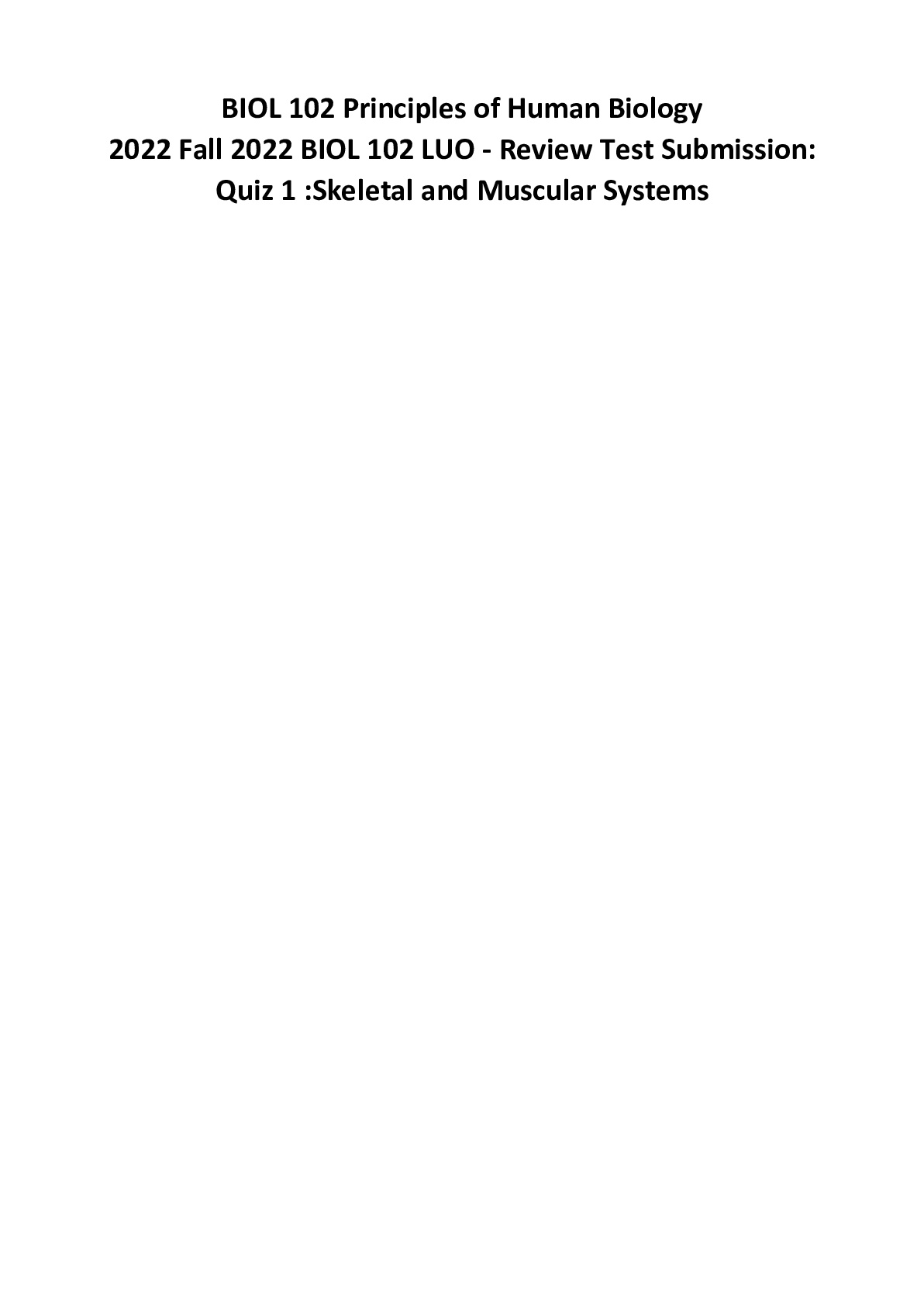

.png)

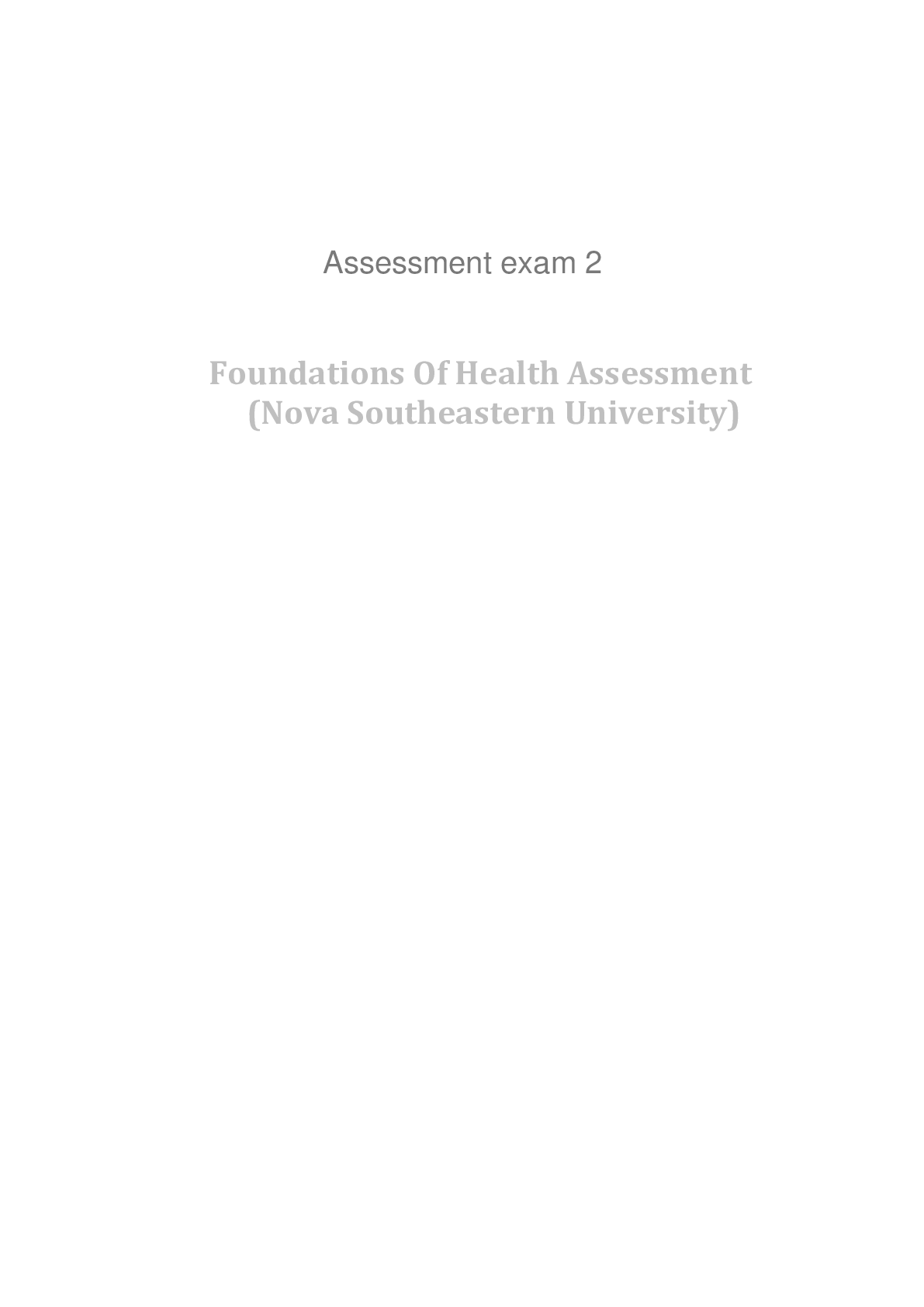
.png)
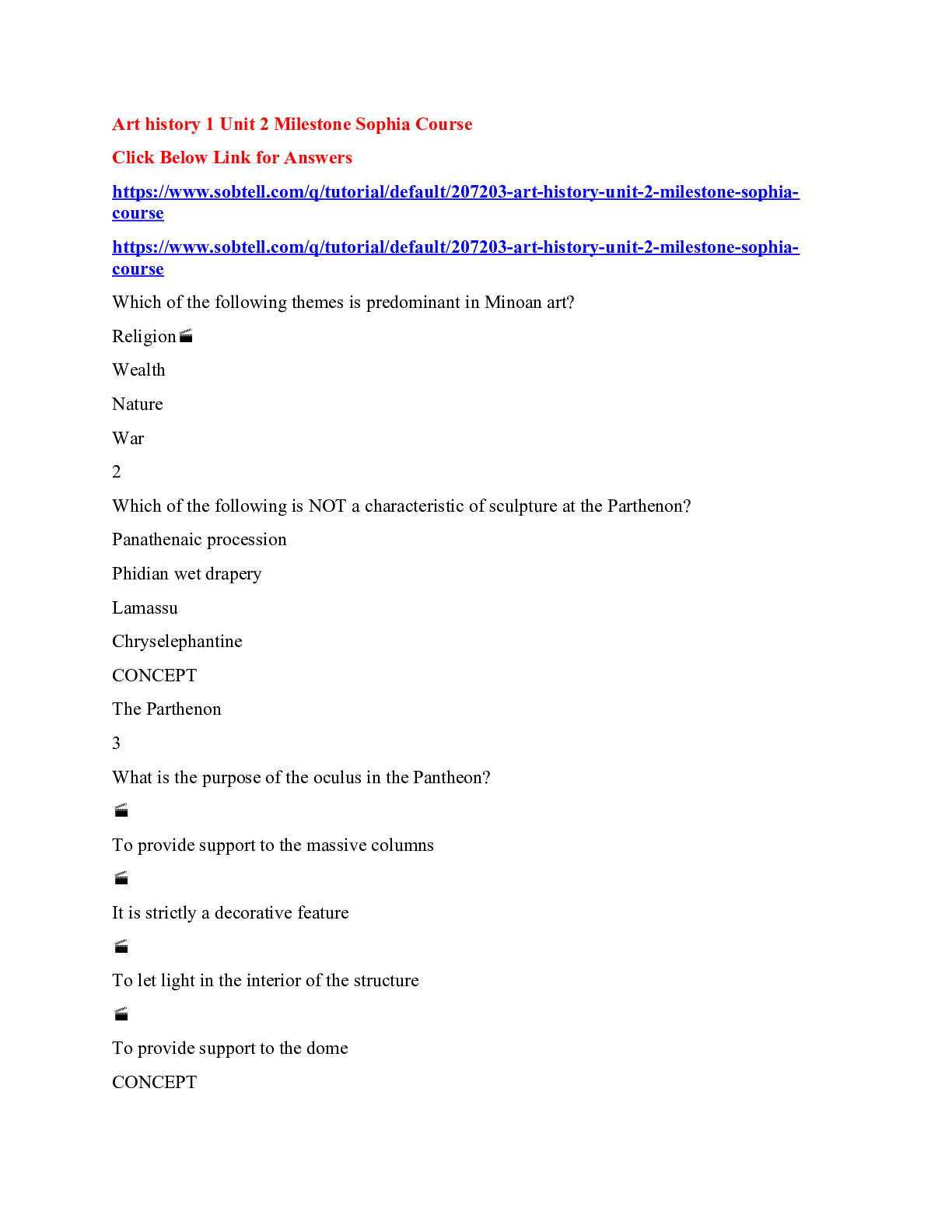




.png)
.png)


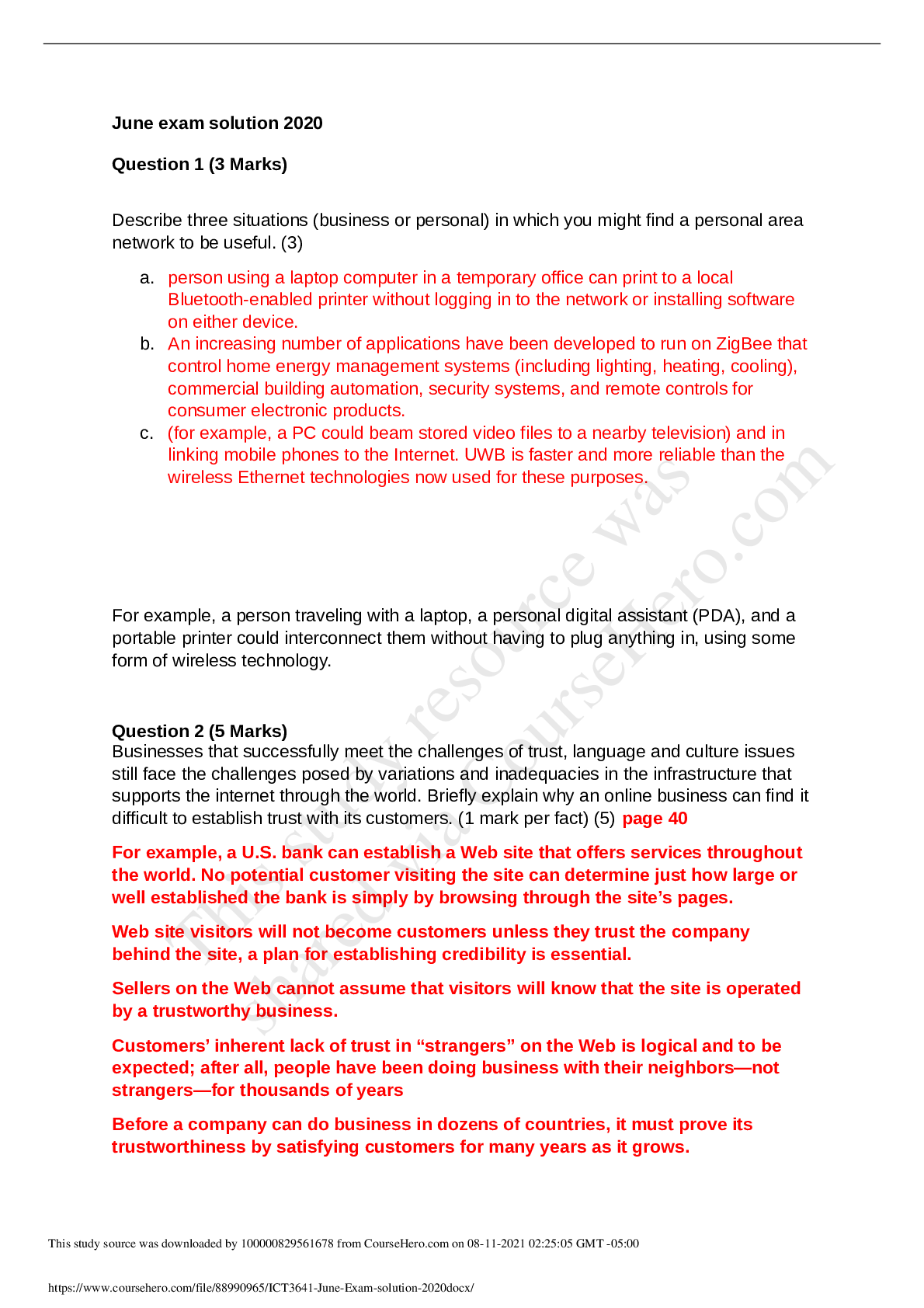




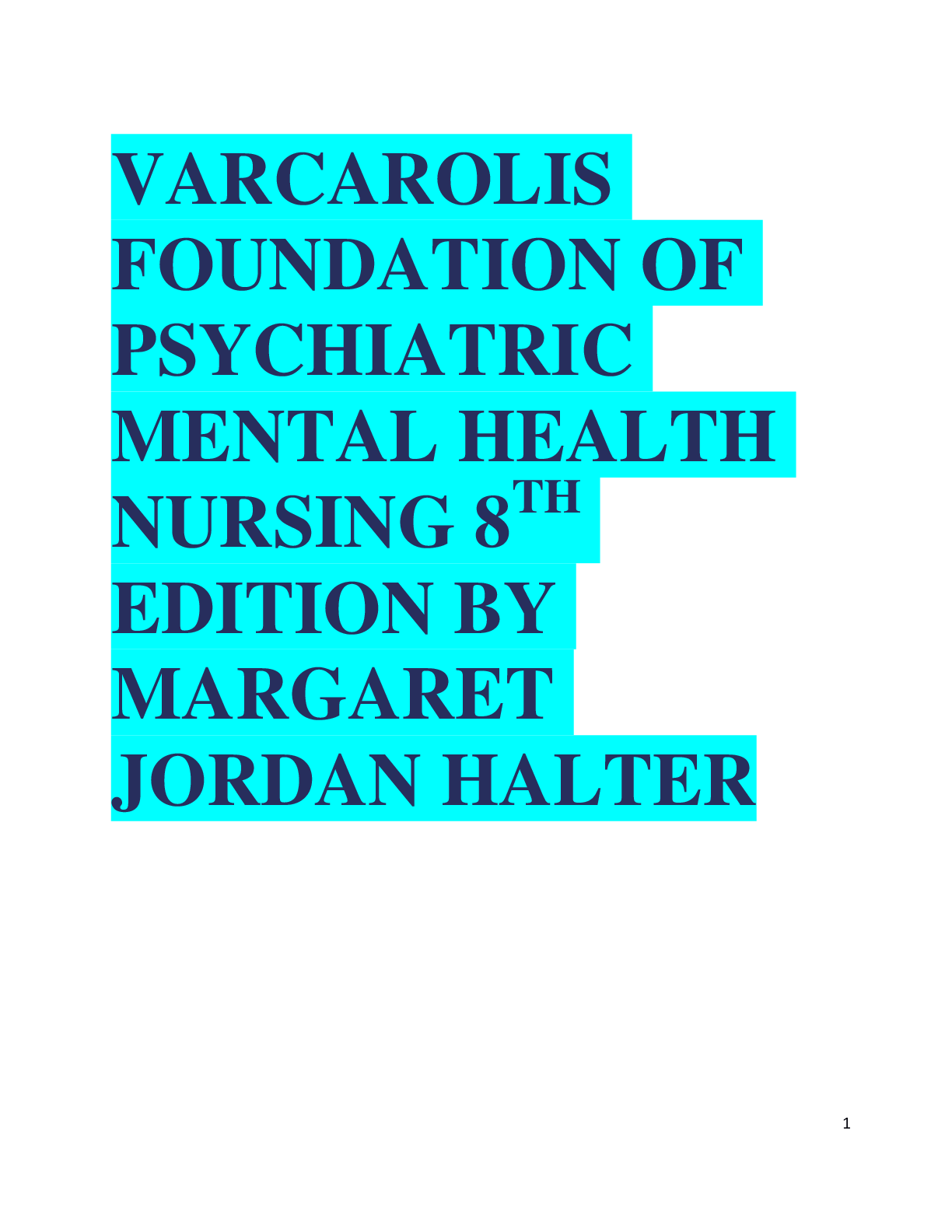

.png)
.png)
.png)
.png)
.png)
.png)
.png)
.png)
.png)
.png)
.png)
.png)

